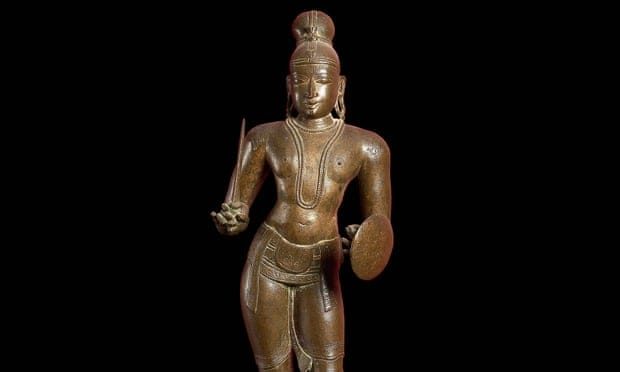India asks Oxford museum to return ‘stolen’ cultural asset

Thirumangai Azhwar (Ashmolean Museum)
By Peter Jaegeul Song
Staff Reporter at Asia N
London: The Indian government has officially requested that the Ashmolean Museum in Oxford return a 15th century bronze idol that was apparently stolen from a temple in India during the 1960s.
The Indian high commission in London stated that a formal request for restitution of the statue of Saint Tirumankai Alvar was put out last Friday.
Such a move comes after the Ashmolean informed the high commission last December of new research that questioned the origin of the sculpture, which was bought by the museum from Sotheby’s auction house in London in 1967.
This one metre tall sculpture depicts Tirumankai Alvar, one of the Tamil poet-saints of south India, holding a sword and shield. The revered saint, who lived in the 8th or 9th century, was a chieftain, a military commander, and a bandit before converting to the Vaishnava tradition of Hinduism.
Rahul Nangare, the first secretary of the Indian high commission in London, said it had received a report from police in Tamil Nadu that unambiguously shows that the original idol has been stolen and replaced with a fake one, and that the stolen idol is the same one that is presently with the Ashmolean.
“Therefore, we have conveyed our formal request to them for restitution of the idol to India. The idol wing is now further investigating the matter about the original theft and subsequent smuggling out of the idol,” said Nangare.
Nangare appreciated the Ashmolean for taking bold steps to alert the high commission and expressed hope that “other museums would follow the example in dealing with suspected stolen pieces of our cultural heritage”.
He said the Ashmolean was carrying out further due diligence on the provenance of the sculpture, with a museum official scheduled to visit India shortly.
A spokeswoman for the Ashmolean made it clear there had been no claim against the sculpture. “The museum acquired the statue in good faith. According to Sotheby’s catalogue the bronze was sold from the collection of Dr JR Belmont (1886-1981),” she said.
“We currently have no indication of how the bronze entered his collection and we are continuing to investigate with the support of the Indian high commission.”
The Ashmolean said that the scholar’s research had also raised questions over the provenance of several other bronzes in collections in Europe and the US. “Further research will be needed to determine whether they were taken out of [India] legally or otherwise,” the spokeswoman added.
De-accessioning the sculpture would require the approval of the art and archeology museum’s board and the vice-chancellor of Oxford University.



















































